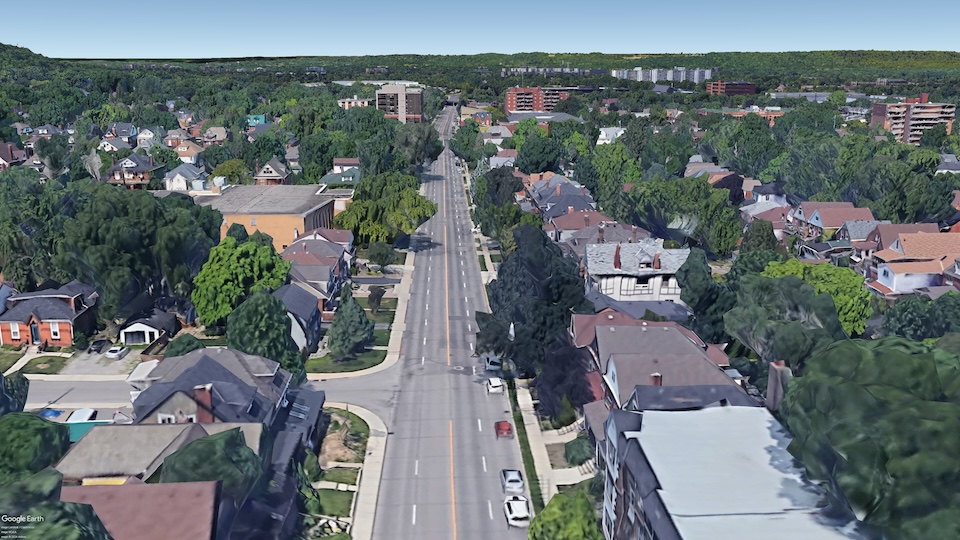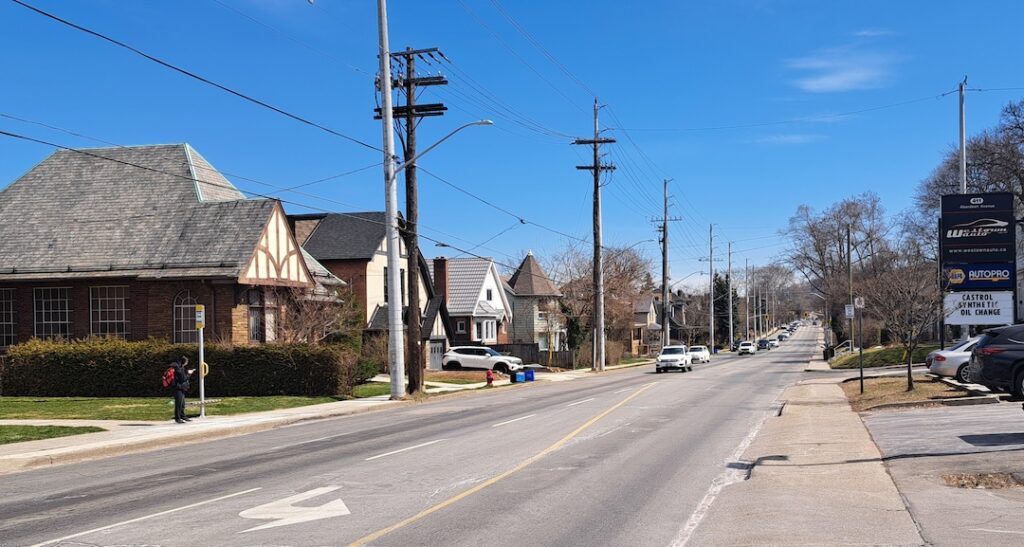Have we reached the end of the stroad?

Hamilton’s progress on becoming a more livable and sustainable city must include eliminating corridors in dense urban neighbourhoods that should be flourishing with people and commerce but instead prioritize traffic speed and volume.
Slowly, but surely, Hamilton is making progress on becoming a more livable and sustainable city. The latest step forward is the change in planning rules to allow “gentle density” in neighbourhoods.
Gentle density includes types of housing that are more dense than the typical single-detached homes, but not as intense as high-rises – think townhouses, triplexes and fourplexes. The density could come from new builds or from the conversion of existing houses into multiple dwelling units. The area impacted by these changes to zoning rules is huge – 75 per cent of Hamilton’s low-density residential areas.
This change comes, in part, as a result of the major public push back against the idea of growing with urban sprawl. Sprawl would have largely allowed a “business as usual” approach to housing, which is unsustainable both economically and environmentally. Instead, with the public push back, the idea of allowing a greater variety of housing types within the existing urban area became central to the debate.
Flash forward to 2024 and it appears that a firm urban boundary is in place and, as a consequence, the adoption of rules to allow more housing types to accommodate growth. This will help a number of issues, including housing affordability and housing choice, which is great for people across the age spectrum, from those who are younger and just starting out to older residents looking to downsize but stay in their own neighbourhoods.
Further, this also means Hamilton can meet provincial housing targets as well as create more tax revenue from the same area of land. As one astute councillor observed: “If we can get more tax productivity per acre, which is what this zoning will do, that’s better for everybody because it reduces the tax burden on all of us.”
However, increasing the density in existing neighbourhoods is only one part of the city-building puzzle and should not be separated from improving the quality of life within those neighbourhoods. Some residents are understandably concerned about what the new development rules will mean for their neighbourhoods.

The best way to address those concerns is to broaden the debate beyond housing to focus on the elements that contribute to quality of life, and one of the primary elements is the overall design of those neighbourhoods. This includes the development of amenities like parks and trails as well as the transportation infrastructure including roads and transit.
The ability to easily and safely walk to and from home to the local park, school, or shop is an important marker of a neighbourhood’s livability and connectedness. Unfortunately, in many instances, we are still living with the poor planning choices from previous decades. The state of our transportation network is an example of this.
One of the major legacies of our past decisions, is the large number of “stroads” that can be found throughout the city. Stroads are a type of thoroughfare that is mix of a street and a road. The term was coined by American civil engineer and urban planner Charles Marohn.
Marohn argues that streets and roads are two different things. Streets are places that build community wealth and health. They are complex environments where life in the city happens, where pedestrians, cars and buildings are close to the sidewalk for easy accessibility, with many property entrances/exits to and from the street. In these environments, a high level of pedestrian activity is the indicator of prosperity. Successful streets are environments where humans, and human interaction, flourish.
By contrast, the purpose of a road is to connect productive places to each other in an efficient manner. It is a high-speed connection between two places with wide lanes and limited entrances and exits. Think of a highway with limited interchanges. You can get from A to B quickly, but there are not many stops along the way.
As suggested by their name, “stroads” are a mix of these two types. Marohn likens them to “the futon of transportation because, just as a futon is neither a particularly good bed nor a particularly good couch, a stroad is
neither a particularly good road or a particularly good street.”
Stroads are typically unsafe, not friendly for pedestrians, and are underperforming from the standpoint of generating community wealth in terms of being a destination. According to Marohn, the problem with stroads is that
engineering codes tend to emphasize speed and vehicle traffic flow rather than safety, so that stroads try to be “all things to all people” but end up failing in every way, as a result.

With this definition in mind, think of all the stroads around Hamiton that fit this description. You could argue that the mass conversion of streets to one-way traffic back in the 1950s instantly converted a bunch of once-vibrant streets into stroads.
Others have devolved over years to arrive at their current state. One example is Aberdeen Avenue, west of Queen Street. By any objective measure, Aberdeen should be one of the grand residential boulevards in Hamilton. It bisects a vibrant neighbourhood, connecting children to several schools, parks and a commercial district.
Along the street itself, there is a great mix of housing densities and architecture and a mature tree canopy lining both sides. Aberdeen should be a fantastic destination for pedestrians and residents. However, by the City’s own admission, Aberdeen isn’t a safe corridor, with speeding vehicles rushing through the neighbourhood as quickly as possible. As a consequence, it is a place that is avoided by pedestrians young and old. So what can be done?
The challenge of stroads isn’t a new problem, or isolated to Hamilton. First, at a city-wide level, the conversion of many one-way streets back to two-way, was an important step. Next is fixing the design of the stroads themselves. In 2022, the City introduced new guidelines to deal with these corridors. The Complete Streets Design Manual sets out categories for streets and then suggests how they should be designed to function better.
However, the key thing is deciding under what category the street should fall. In some cases, this is simple as many streets across Hamilton fit neatly into one of the categories suggested by the manual. However, for stroads like Aberdeen, the manual requires that a choice be made. Either the corridor will lean toward being a street, and therefore become more pedestrian friendly and fulfil its neighbourhood potential, or it will continue as a stroad and remain dangerous and not serve the community in the way it can.
So who makes the choice of what a stroad should become? Like all choices about how we shape our urban environment, it is a public choice. The roadway area between sidewalks is not a sacred space for cars to which we have limited or no control to change. While staff can provide recommendations on options and implications, this is ultimately a choice to be made by residents, through their representatives on city council.
These are the types of important choices that are at the core of city building. Much like the recent decisions on limiting urban sprawl and building more gentle density, the public decision to design our streets better is another important step on the path towards creating a more livable and sustainable city.
Paul Shaker is a Hamilton-based urban planner and principal with Civicplan.












